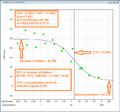IC50 facts for kids
The IC50 (pronounced "eye-see-fifty") is a special measurement that helps scientists understand how strong a medicine or other substance is. It tells us how much of that substance is needed to stop a certain biological process by half. Think of it like this: if something is causing a problem in your body, the IC50 tells us how much medicine it takes to reduce that problem by 50%.
Scientists use IC50 a lot in medicine research. It helps them figure out how powerful a new medicine is, especially medicines that are designed to block or stop something from happening in the body.
Sometimes, you might also hear about pIC50. This is just another way to write IC50, using a different math scale. Higher pIC50 values mean the substance is much, much stronger.
According to the FDA, which is a group that makes sure medicines are safe, IC50 specifically means the amount of a medicine needed to stop something by 50% when tested in vitro. This means "in a test tube" or "in a lab dish," not inside a living body.
IC50 is similar to another measurement called EC50. While IC50 is for substances that *stop* things, EC50 is for substances that *start* or *help* things happen. EC50 tells us how much of a medicine is needed to get 50% of its best possible effect when tested in vivo, which means "inside a living body."
Contents
What is IC50?
The IC50 value helps scientists compare different medicines or substances. It shows how much of a substance is needed to reduce a specific activity by half. For example, if a medicine is meant to stop a certain enzyme from working, the IC50 would tell us the amount of that medicine needed to make the enzyme only work half as well as it normally would.
Why is IC50 Important?
Understanding IC50 is super important for developing new medicines.
- Finding Strong Medicines: It helps researchers find the most powerful substances that can stop a problem with a small dose. A lower IC50 value means the substance is more effective.
- Comparing Medicines: It allows scientists to compare how well different medicines work against the same problem.
- Safety: Knowing the IC50 helps scientists figure out safe and effective doses for medicines.
How Do Scientists Find IC50?
Scientists perform experiments to find the IC50. They take a biological process, like a group of cells or an enzyme, and then add different amounts of the substance they are testing. They measure how much the substance stops the process at each amount.
Then, they plot these results on a graph. The graph usually shows the amount of the substance on one side and how much it stopped the process on the other. The IC50 is the point on the graph where the substance has stopped the process by exactly 50%.
What Does IC50 Stop?
The "biological process" that IC50 measures can be many different things. Here are some examples:
- Enzymes: These are tiny proteins in your body that help chemical reactions happen. A medicine might stop an enzyme that is causing a disease.
- Cells: Medicines can be designed to stop certain cells from growing, like cancer cells.
- Receptors: These are like tiny "locks" on the surface of cells. Medicines can act like "keys" that block these locks, stopping a signal from getting through.
- Microorganisms: This includes tiny living things like bacteria or fungi that can cause infections. Medicines can stop them from growing or harming the body.
IC50 vs. EC50
It's easy to get IC50 and EC50 mixed up, but they are used for different types of medicines:
- IC50 (Inhibitory Concentration): This is for medicines that *inhibit* or *stop* something. Think of it as a "blocker."
- EC50 (Effective Concentration): This is for medicines that *activate* or *start* something, or cause a desired effect. Think of it as an "activator."
Both measurements are important for understanding how medicines work and how much of them are needed to have an effect.
Images for kids


